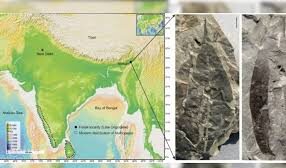Prelims Bits

Context:
Scientists have uncovered fossilized leaves, dating back approximately 24 million years, in Assam’s Makum Coalfield, which resemble modern-day Nothopegia plants currently found in the Western Ghats.
Details of the Discovery:
- Geological Age:
The fossils belong to the Late Oligocene epoch (around 24–23 million years ago), a period known for significant global climatic cooling and changes in vegetation patterns. - Location:
The fossils were found in the Makum Coalfield, a Tertiary-age geological site in Assam, known for its rich plant fossil deposits. - Methods Used:
- Herbarium Comparison: Matching fossil leaves with preserved modern plant specimens.
- Cluster Analysis: Statistical grouping of plant characteristics to establish similarities.
- CLAMP (Climate Leaf Analysis Multivariate Program): A tool to reconstruct past climate conditions using fossil leaf traits and modern plant datasets.
Key Insights from the Study:
- The rise of the Himalayas altered the climate of northeast India, leading to:
- Lower temperatures
- Disruption of rainfall and wind systems
- Conditions unsuitable for tropical flora, including Nothopegia
- These environmental shifts likely led to the local extinction of Nothopegia in northeast India. However, the plant lineage survived in the Western Ghats, where it became endemic.
Significance of the Discovery:
- Highlights the long-term impact of climate change on species distribution, extinction, and survival.
- Offers valuable insights into plant migration patterns and how species respond to climatic upheavals—vital for predicting future impacts of global warming.
- Underscores the importance of biodiversity hotspots like the Western Ghats, which act as refuges for ancient and rare lineages.
About Nothopegia:
- Taxonomy: Belongs to the Anacardiaceae family.
- Geographical Range: Found in India, Bangladesh, and Sri Lanka.
- Indian Distribution:
- Of the 11 known species, 8 occur in India.
- All except Nothopegia heyneana are confined to the Western Ghats and southwestern India.
- Morphological Features:
- Small deciduous trees
- Simple leaves
- Unisexual flowers with four parts (tetramerous)
- Fruits are drupaceous (stone fruits)




